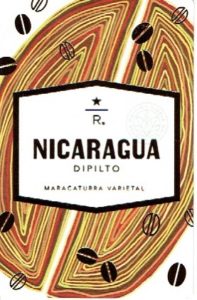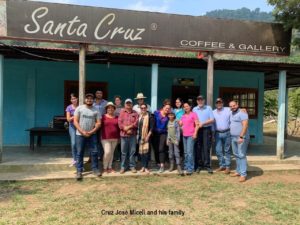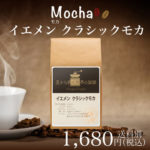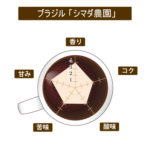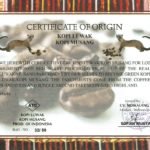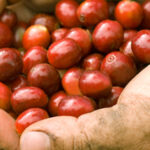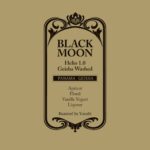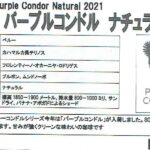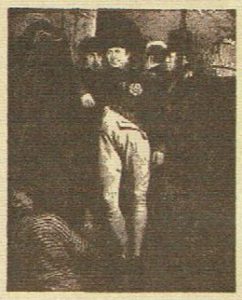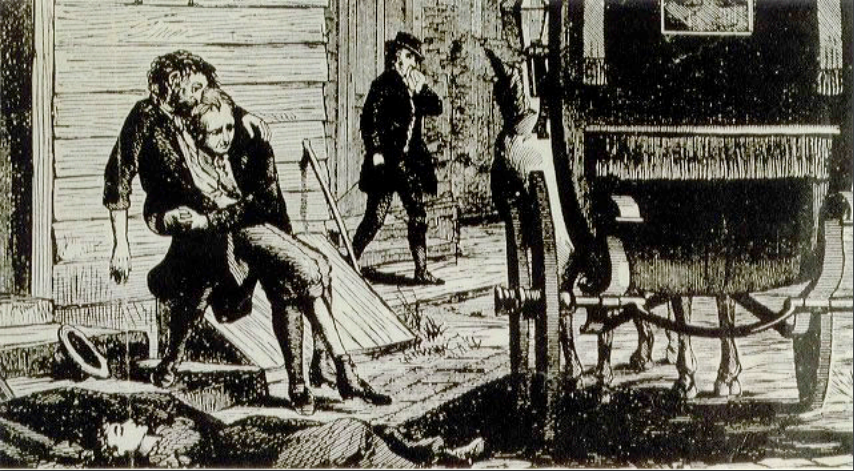
1793年フィラデルフィアの黄熱病と腐敗したコーヒー
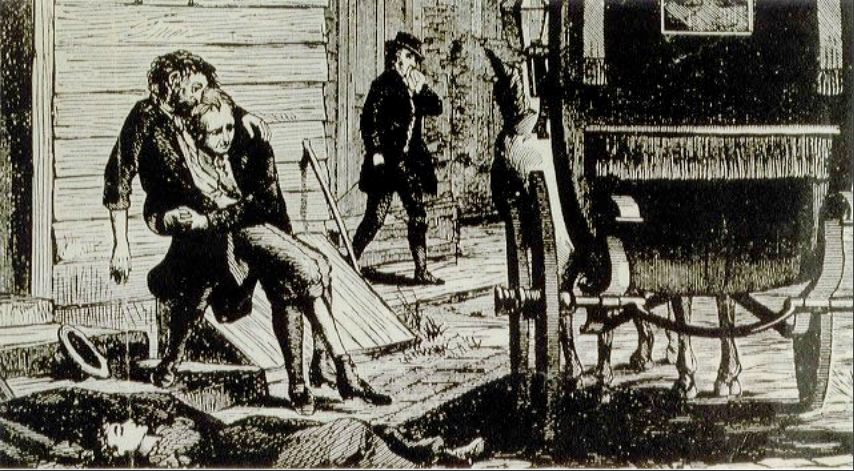
1793年、アメリカ合衆国ペンシルベニア州南東部フィラデルフィア(Philadelphia)が黄熱病に襲われた。フィラデルフィアは当時北米最大の都市であり、約50,000人の港湾都市であった。1790年に首都がニューヨーク市からフィラデルフィアに遷都したことにより、アメリカ合衆国の首都であり、ペンシルベニア州の州都でもあった。
流行はデラウェア川の主要港近くの住人から始まり、夏から秋に急速に広がり、市内全体にパニックを引き起こした。連邦政府、州、市の職員など、人口の半分は避難し、都市機能は崩壊した。
この黄熱病のエピデミック(Epidemic)によって、8月から11月までの間に約5,000人が死亡したと推定されている。フィラデルフィアの人口の約1/10が失われた計算になる。
黄熱病
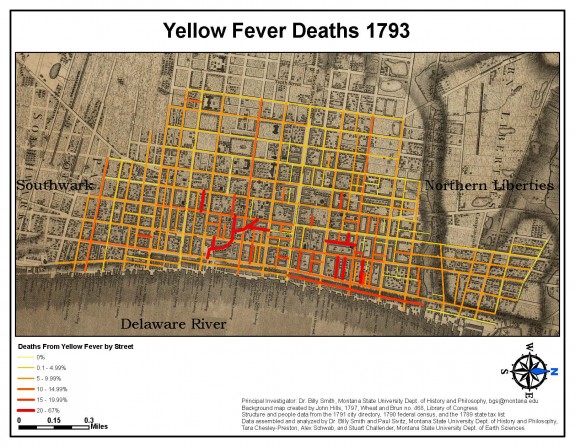
The 1790sより
黄熱病(Yellow fever)は、フラビウイルス科フラビウイルス属(Flavivirus)の黄熱ウイルスによる感染症である。
黄熱ウイルスとこのウイルスの宿主であり人への感染の媒介となる蚊(Aedes aegypti)は、アフリカ起源であると言われる。これらは奴隷貿易によって大西洋を横断し、西インド諸島で風土病となった。この感染症が北米に広がるのは時間の問題だった。
黄熱病の流行の最初の記録は、「バルバドス・ジステンパー(Barbados Distemper)」と呼ばれた1647年にバルバドスで発生した流行であった。このバルバドス・ジステンパーは、1699年にフィラデルフィアを襲い、約220人の命を奪った。フィラデルフィアにこの感染症が持ち込まれたのは、フィラデルフィアが早い段階から西インド諸島と交易を行っていたためであった。
ここから約100年間、フィラデルフィアの黄熱病の流行は間欠的に起こった。重大なアウトブレイク(Outbreak)は、1741年、1747年、1762年に発生したが、1790年代の大流行までは、政治的に大きな影響を与えるには至らなかった。
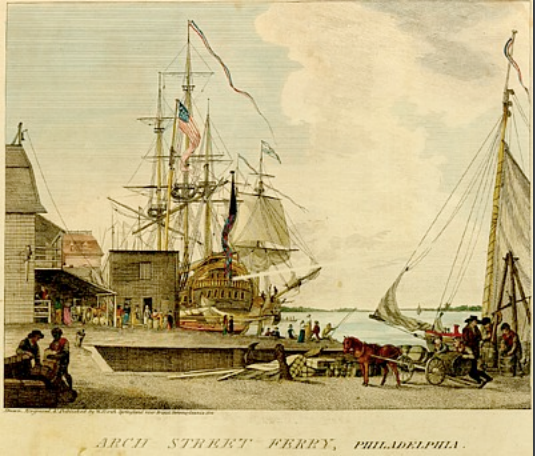
最後の流行から約30年後、1793年にフィラデルフィアで黄熱病の発生が確認されたとき、最初の段階ではアーチ・ストリート(Arch Street)近くの波止場周辺の住人に発熱が集中していた。
ベンジャミン・ラッシュ
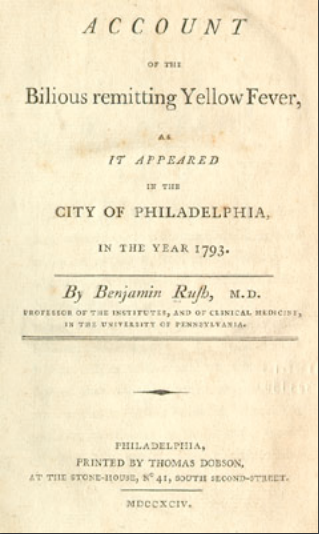
The origin of this fever was discovered to me at the same time, from the account which Dr Foulke gave me of a quantity of damaged coffee which had been thrown upon Mr. Ball's wharf, and in the adjoining dock, on the 24th of July, nearly in a line with Mr. Le Maigre's house, and which had putrefied there to the great annoyance of the whole neigbourhood.
After this consultation I was soon able to trace all the cases of fever which I have mentioned to this course. Dr. Hodge lived a few doors above Mr. Le Maigre's where his child had been exposed to the exhalation from the coffee for several days. Mrs. Bradford had spent an afternoon in a house directly opposite to the wharf and dock on which the putrid coffee had emitted its noxious effluvia, a few days before her sickness, and had been much incommoded by it. Her sister, Mrs. Leaming, had visited her during her illness at her house, which was about two hundred yards from the infected wharf. Young Mr. McNair and Mrs. Palmer's two sons had spent whole days in a compting house near where the coffee was exposed, and each of them had complained of having been made sick by its offensive smell, and Mr. Aston had frequently been in Water-street near the source of the exhalation.
This discovery of the malignity, extent, and origin of a fever which I knew to be attended with great danger and mortality, gave me great pain. I did not hesitate to name it the bilious remitting yellow fever.
Benjamin Rush(1794)「An Account of the Bilious Remitting Yellow Fever, as it Appeared in the City of Philadelphia, in the Year 1793」,p11-13
この都市の高名な医師であり、独立宣言起草者の一人でもあるベンジャミン・ラッシュ(Benjamin Rush)は、患者の身体の状態、病状の経過、毎日の死亡者統計、フィラデルフィアの気象条件、大気の状態などの様々な資料を突き合わせ、黄熱病の原因を探った。彼の黄熱病に関する仕事は、『1973年のフィラデルフィアの胆汁性寛解型黄熱病の報告(An Account of the Bilious Remitting Yellow Fever, as it Appeared in the City of Philadelphia, in the Year 1793)』にまとめられた。
その結果、彼はデラウェア川の波止場に陸揚げされた貨物に含まれていた「傷んだコーヒー(damaged coffee)」が黄熱病の原因であると考えた。
彼は、黄熱病の最も初期の発症例であったブラッドフォード夫人(Mrs. Bradford)が、発症する数日前に波止場の真向かいの家で午後を過ごし、「腐敗したコーヒーが放つ有害な悪臭(the putrid coffee had emitted its noxious effluvia)」の被害を受けていたことに注目した。
また、彼女の妹が、他の住人もこの有害な悪臭の被害を訴えていると報告したことから、ラッシュは、悪臭を放つ「傷んだコーヒー」が、この感染症の原因であるに違いないと結論付けた。
ミアスマ(瘴気)
黄熱病は今日では、黄熱ウイルスを媒介する蚊によって感染することがわかっている。しかし、当時は原因不明の病であり、「ミアスマ(Miasma、瘴気)」と呼ばれる悪い空気が感染の原因であるという考えが支配的であった。マラリアの語源がイタリア語の「悪い空気(Mala Aria)」であることからも見て取れるように、人から人へ直接伝染しない感染症の場合は、ミアスマが感染の原因であると考えられがちであった。
ラッシュは、フィラデルフィアで夏場になると沼や湿地から異常発生する蚊の多さに注目していた。しかし、黄熱病は夏場になると毎年流行するわけではなかったので、それは原因とはみなされなかったのである(逆にコレラを調査したジョン・スノウ(John Snow)は、その感染源として水に着目した。コレラは汚染された水が最も重要な感染源であるため、ミアスマという概念による認知バイアスを取り除きやすかったのかもしれない)。
1799年、フィラデルフィア当局は、フィアデルフィア市の南西約16kmにあるティニカム・タウンシップ(Tinicum Township)に、「フィラデルフィア・ラザレット(Philadelphia Lazaretto)」という最先端の検疫所と病院を建設した。黄熱病が流行する温暖な時期には、フィラデルフィアに向かってデラウェア川を航行するすべての船は、検査のためにそこに停泊する必要があった。健康な乗客と乗組員、そして、状態が良好であると思われた貨物は入港を許可されたが、疑わしいものはすべて持ち込みが禁止され、消毒のために降ろされた。
長い間、当局と医師たちは、「感染した」物質は感染した人間よりも危険であると確信していた。1860年の検疫規則では、「商品、衣類、手荷物の悪臭(foul merchandise, clothing, and baggage)」は、「罹患した病人の身体(the body of the sick afflicted therewith)」よりも、病気を広める可能性がはるかに高いと書かれていた。
またこの規則では、黄熱病の患者は許可が下りれば都市に入ることができるが、荷物は消毒のために拘束することが提案されていた。船舶、貨物、衣類、手荷物は、完全に消毒が終わるまでは、入港や持ち込みが禁止の扱いだったのである。
当時は、外国の船舶は船倉の貨物とともに「悪い空気」を輸送することができ、感染を貨物輸送の目的地にまで広めることができる、と考えられていた。当時の医師であったA. N. ベル(A. N. Bell)は、「乗船した黄熱病の原因、悪性度、および持続性について(On the Cause, Malignancy, and Persistence of Yellow Fever Aboard Ship)」という論文の中で、次のように述べている。
Stagnant air, dampness, darkness, and warmth are frequently the inseparable conditions of the holds of vessels in warm climates. If to these conditions there be added a filthy vessel, putrid provisions, or bad water; or if the cargo consist of material peculiarly liable to infection, such as rags, hides, feathers, sponge, or sugar, the circumstances are then complete not only for the reception of the poison, but for its origination and continuance.
A. N. Bell(1864)「On the Cause, Malignancy, and Persistence of Yellow Fever Aboard Ship」
コーヒーだけではなく、当時は紙を作るために使用されていた獣皮も黄熱病の原因として疑われた。それらはすべて西インド諸島からフィラデルフィアに送られてきた貨物で、輸送の途中でおそらく濡れたか、加工が不十分で腐ったために、ひどい悪臭を放っていた。
また、綿、ウール、リネン製のカビの生えたボロ布なども、「特に感染しやすい物質(material peculiarly liable to infection)」に加えられた。コーヒー商人や保険当局は、湿気と温かさが「特に感染しやすい物質」を腐敗させ、そして腐敗した物質が感染を引き起こすと考えていたようである。
フランシス・B・サーバー(Francis Beatty Thurber)の1881年の著書、「コーヒー;プランテーションからカップへ(Coffee; from Plantation to Cup)」によると、19世紀の中南米の貨物船では、コーヒーと獣皮は同じ貨物に混ぜられた状態で輸送されていたようだ。都会的なコーヒー・ハウスで飲まれる魅惑的な香りを放つコーヒーも、不潔ななめし革工場で生産される獣皮と同様に腐敗したものとして取り扱われたのである。
Coffee and hides—what two commodities could be more different? The aroma of roasted coffee is as rich and alluring as the stench of decomposing animal flesh is repulsive. The nineteenth-century tannery was dirty and rough, whereas the coffee house was urbane and cultivated. Yet quarantine officials spoke of the two items in similar terms, and often treated them alike. Their kinship lay in the one thing raw coffee beans and incompletely treated animal hides were both liable to do: rot.
DAVID S. BARNES「Cargo, "Infection," and the Logic of Quarantine in the Nineteenth Century」.p82
*当時のコーヒーの貨物のサイズやその廃棄方法については、歴史的資料が残っていないようである。ボストン茶会事件で茶が海に投げ捨てられたように、腐敗したコーヒーは海に投げ捨てられたのかもしれない。
疫病と悪
堕落した旧大陸から逃れ、新大陸に建設された自由で健康な新しい国家は、このような疫病と無縁であるはずだった。しかし1790年代になると、フィラデルフィアなどの大都市が次々に黄熱病に襲われるようになった。
当時のアメリカ合衆国大統領であるトーマス・ジェファーソン(Thomas Jefferson)は、悪は善を生み出す手段であり、黄熱病の流行を大都市化に歯止めをかけるものとして理解した。ジェファーソンにとっては、農業に基盤を置いた小さなコミュニティにこそがユートピアであり、大都市は人間の道徳、健康、自由にとって好ましいものではなかった。そしてラッシュは、ヨーロッパの堕落に対するこのようなアメリカ合衆国の優位性は、農業によってのみ維持されると考えたのだった。
いかにして対処したのか
ラッシュは政治的には自由、平等、博愛の先進的な思想を持っており、貧富貴賤問わず、寝る間も惜しんで黄熱病患者の治療に当たった。しかし、彼が黄熱病の患者に施した治療は、瀉血と下剤という非常に原始的なものであった。
市民は、ミアスマから身を守るために様々なことを試みた。外出時には、疫病に効果があると信じられていた酢や樟脳を染み込ませたハンカチで顔を覆った。酸素量を増やす目的で火薬が使用され、空気を浄化する目的でタールが燃やされた。
しばらく後になって、感染症の原因が微生物、寄生虫、ウイルスであることがわかるようになり、感染症の対策も変化した。しかし、感染症の原因が不明であった当時は、感染症に対する様々な防疫が行われたが、船舶を検疫することを除けば、病気の拡大を防ぐのに有効な対処はほとんど行われなかった。
黄熱病とコーヒー
ちなみに、コーヒーは黄熱病の治療に効果があるのだろうか?ウィリアム・H・ユーカース(William H. Ukers)の『オール・アバウト・コーヒー(All about coffee)』の初版には、以下のような記述がある。
Also it has been reported that in extreme eases of yellow fever, coffee has been used most effectively by many physicians as the main reliance after all other well known remedies have been administered and failed.
William H. Ukers(1922)「All about coffee」.first edition. p182
『オール・アバウト・コーヒー』によれば、他のあらゆる治療法が失敗に終わった後、コーヒーは黄熱病を緩和する最も効果的な治療法として多くの医師に使用されていたようである。医師たちはコーヒーを最後の頼みの綱として使用したようだが、医学的根拠のある使用法ではないだろう。
*この黄熱に関する文章は、「オール・アバウト・コーヒー」の初版の182ページに存在するが、第2版には存在しない。この文章の書かれている"Use of Coffee in Medicine"は、第2版の316ページ、"The Use of Coffee in Medicine"では短縮されており、第2版では初版の182ページを参照するように指示されている。
腐敗したコーヒー

For many years, Ye coffee house, the two London coffee houses, and the City tavern (also known as the Merchants coffee house) each in its turn dominated the official and social life of Philadelphia. The earlier houses were the regular meeting places of Quaker municipal officers, ship captains, and merchants who came to transact public and private business. As the outbreak of the Revolution drew near, fiery colonials, many in Quaker garb, congregated there to argue against British oppression of the colonies. After the Revolution, the leading citizens resorted to the coffee house to dine and sup and to hold their social functions.
William H. Ukers(1935)「All about coffee」,second edition. p121
ウィリアム・H・ユーカース(William H. Ukers)の『オール・アバウト・コーヒー(All about coffee)』によると、フィラデルフィアの最初のコーヒーハウスは、1700年頃に誕生したイー・コーヒー・ハウス(Ye Coffee House)である。初期のコーヒーハウスは、フィラデルフィアの都市形成を担ったクエーカー教徒のたまり場になっていたようだ。その後、フィラデルフィアには様々なコーヒー・ハウスが誕生し、市民社会の基盤となった。
コーヒーは西インド諸島の温暖な地域で生産され、例えば、サン=ドマング(Saint-Domingue)のジェレミー港(Port of Jérémie)のような港から船便で輸送され、検疫に合格し、十分に換気された状態のコーヒーだけがフィラデルフィアに持ち込まれた(当時のアメリカ合衆国はフランス植民地からコーヒーを輸入していた)。しかし、ほとんどの貨物は腐敗の影響を受け、コーヒーはその繊細なフレーバーをひどく傷付けられた。痛んだコーヒーは乾かされ、研磨(Polishing)され仕上げられた後に市場に卸されたが、低い価格で取引されるほかなかった。
*コーヒーを綺麗な外観に仕上げる方法には、「蒸発(Sweating)」、「研磨(Polishing)」、「着色(Coloring)」といった方法があったようだ。そしてこの着色には、有害物質が使われていたようだ(着色に関しては、アメリカ合衆国農務省の1879年のレポート、"Report of the Secretary of Agriculture"に記述がある)。
To some extent in producing countries, and also at the large distributing points, an artificial appearance is given to the bean by "sweating," "polishing," or by the use of coloring matter. By the first-named process Savanilla and other sorts (sometimes Santos) are made to imitate Padang Java. Laguayra is polished and sold for Rio. Very dangerous powders or mixtures are used to color the beans, the practice being resorted to in oder to meet the prejudices of consumers in certain sections for a bright yellow, black, or olive-green colored bean. These colors are obtained by the use of poisonous compounds. The composition of these mixtures respectively, as proved by chemical analyses, is as follows (Report Department Agriculture, 1879, p.79):
Francis Beatty Thurber(1881)「Coffee; from Plantation to Cup」p.20-21
Orange Powder.-Chromate of lead ("chrome yellow"), 1 part ; sulphate of barium("heavy spar"), 2 parts.
Black Powder.-Consisted wholly of burnt bones("crude bone-black").
Olive-Green Powder.-Chromate of lead("chrome yellow"), 1 part ; bone-black, 3 parts ; sulphate of barium("heavy spar"), 3 parts.
Both the natural and the faced berries were examined, with the result that every sample of the "improved" berries was found to have been treated with some powder containing the same substances as those in the above olive-green powder.
腐敗したコーヒーとは、実際どのような味と香りなのだろうか?
このことを検証するために、2014年にペンシルベニア大学のデイビッド・S・バーンズ(David S. Barnes)氏は、「感覚の歴史の実験(A SENSORY HISTORY EXPERIMENT)」という実験を行った。
実験の結果、それは鼻腔から脳にまで突き抜けるような悪臭を放ち、「延々と後を引く吐瀉物(Lingering vomit)」のような味だったようである。バーンズ氏は、そのあまりに強烈な悪臭のために、これが黄熱病の原因であると考えられたのも不思議ではないと述べている。
このことは、18世紀後半のアメリカ合衆国でどのようなコーヒーが飲まれていたのかについての手がかりを与えてくれる。当時のコーヒーは、非常に悪い輸送や保管状態にあり、現在飲まれているようなコーヒーよりもはるかにひどい味がしたはずである。
コーヒーは黄熱病の原因と考えられ厳しく検疫された。そして、検疫を合格したコーヒーもひどく傷んだものが多かったはずだ。それでも当時の人々はコーヒーを飲むのを止めなかった。「このような制限はフィラデルフィアでのコーヒーや動物の獣皮の需要を減少させるものではまったくなかった(Such restrictions did nothing to diminish demand for coffee and animal hides in Philadelphia)」のである。
一体いかなる魅惑が人にコーヒーの飲用を続けさせたのか?疫病、悪臭、ひどい味、それにも関わらず飲まれ続けたコーヒー。ここにはコーヒーの魅惑を探るための手がかりが隠されているのかもしれない。
*フィラデルフィアの黄熱の流行は様々な議論を促し、ジャーナリズムや文学の発展に寄与した。1793年のフィラデルフィアの黄熱病の流行を題材にした文学作品には、チャールズ・ブロックデン・ブラウン(Charles Brockden Brown)の『アーサー・マーヴィン(Arthur Mervyn; or, Memoirs of the Year 1793)』、ローリー・ハルゼ・アンダーソン(Laurie Halse Anderson)の『フィーバー 1793(Fever 1793)』がある。『フィーバー 1793』の主人公、マチルダ・クック(マッティ)(Matilda Cook"Mattie")の母親は、コーヒー・ハウスを経営している。
*言うまでもなく、黄熱の研究をした日本の研究者に野口英世がいる。
<参考>
William H. Ukers「All about coffee」
Francis Beatty Thurber(1881)「Coffee, from Plantation to Cup: A Brief History of Coffee Production and Consumption, with an Appendix Conntaining Letters Written During a Trip to the Coffee Plantations of the East and Through the Coffee Consuming Countries of Europe」<https://books.google.co.jp/books?id=AIIPAAAAYAAJ&hl=ja&source=gbs_navlinks_s>
Benjamin Rush(1794)「An Account of the Bilious Remitting Yellow Fever, as it Appeared in the City of Philadelphia, in the Year 1793」<https://archive.org/details/DKC0020/mode/2up>
A. N. Bell(1864)「On the Cause, Malignancy, and Persistence of Yellow Fever Aboard Ship」<https://www.ncbi.nlm.nih.gov/pmc/articles/PMC5523486/>
J. Johnson(1795)「The Analytical Review, Or History of Literature, Domestic and Foreign, on an Enlarged Plan, 第 21 巻」<https://books.google.co.jp/books?id=W2JEAQAAMAAJ&hl=ja&source=gbs_navlinks_s>
西川秀和「死者4,000人。18世紀アメリカで疫病が流行した時に起きたこと。」<https://note.com/filius/n/n1fa15e735ba8>
小川眞里子、財部香枝(1998)「フィラデルフィアの科学者たち : 独立間もないアメリカの博物学と医学」<https://mie-u.repo.nii.ac.jp/?action=pages_view_main&active_action=repository_view_main_item_detail&item_id=1287&item_no=1&page_id=13&block_id=21>
山崎茂明(2007)「19世紀フィラデルフィア医学ジャーナリズムの展開」<https://www.jstage.jst.go.jp/article/johokanri/50/2/50_2_87/_article/-char/ja>
Simon Finger「Yellow Fever」,Encyclopedia of Greater Philadelphia<https://philadelphiaencyclopedia.org/archive/yellow-fever/>
「Philadelphia and Its People in Maps: The 1790s」,Encyclopedia of Greater Philadelphia<https://philadelphiaencyclopedia.org/archive/philadelphia-and-its-people-in-maps-the-1790s/>
「An Account of the Bilious Remitting Yellow Fever, as it Appeared in Philadelphia, in the Year 1793 (1815) by Dr. Benjamin Rush (1746-1813)」,History 135F <https://faculty.humanities.uci.edu/bjbecker/PlaguesandPeople/week7c.html>
「Can old coffee cause yellow fever?」,WHYY<https://whyy.org/segments/can-old-coffee-cause-yellow-fever/>
「When Coffee Cargo Was Quarantined」,JSTOR Daily<https://daily.jstor.org/when-coffee-cargo-was-quarantined/>
「When New Yorkers Burned Down a Quarantine Hospital」,JSTOR Daily<https://daily.jstor.org/when-new-yorkers-burned-down-a-quarantine-hospital/>
「John Snow and the Birth of Epidemiology」,JSTOR Daily<https://daily.jstor.org/john-snow-and-the-birth-of-epidemiology/>
「19th-Century Nurses’ Fight to Battle Yellow Fever」,JSTOR Daily<https://daily.jstor.org/19th-century-nurses-fight-to-battle-yellow-fever/>
DAVID S. BARNES「Cargo, "Infection," and the Logic of Quarantine in the Nineteenth Century」,Bulletin of the History of Medicine, Vol. 88, No. 1 (Spring 2014), pp. 75-101The Johns Hopkins University Press.<https://www.jstor.org/stable/26308892?mag=when-coffee-cargo-was-quarantined&seq=1>

